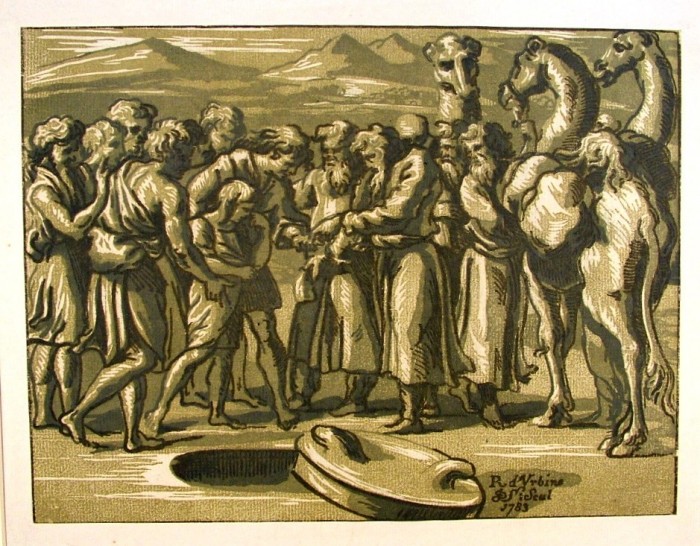Joseph Sold by His Brothers, chiaroscuro woodcut after Raphael

John Skippe (1742-1811), Joseph Sold by His Brothers, chiaroscuro woodcut after Raphael, 1783. [with these inscriptions in the plate lower right: R d’Urbino JS: Scul 1783 indicating that Raphael of Urbino is responsible for the composition and John Skippe for the print]. In good condition, mounted on a sheet of old cream laid paper, trimmed on the borderline; 8 1/4 x 11 1/4 inches; archival mounting.
A fine fresh impression of this rare chiaroscuro woodcut, printed in four blocks: light and medium olive green, dark grayish green and dark brown.
Provenance: ex Collection: Mr. and Mrs. Percy Simmons
Exhibited: Beyond Black and White, Chiaroscuro Prints, Indiana University Art Museum, and Indianapolis Museum of Art; 1989-90; number 55 in the catalogue.
Joseph Sold by His Brothers is based on the fresco designed by Raphael and executed in the Vatican by his assistant Polidoro da Caravaggio. Skippe has added three pyramids in the background, which were not in the original fresco – these may represent his own reaction to the slaver market he personally witnessed when he visited Cairo – he was appalled at the scene, and may be using this Biblical scene as an opportunity to depict it.
Skippe was a gentleman painter who made a series of chiaroscuro woodcuts, often based on paintings or drawings he had in his collection, to please himself and his friends. Because these were not distributed in large numbers commercially (Skippe was independently wealthy) they are quite scarce and rarely seen today. The Victoria and Albert Museum, and the British Museum are strong repositories of his work; in the United States small Skippe collections can be found at the Yale Center for British Art, the Cincinnati Museum of Art, and the Chicago Art Institute. Skippe prints are rarely encountered today on the print market.